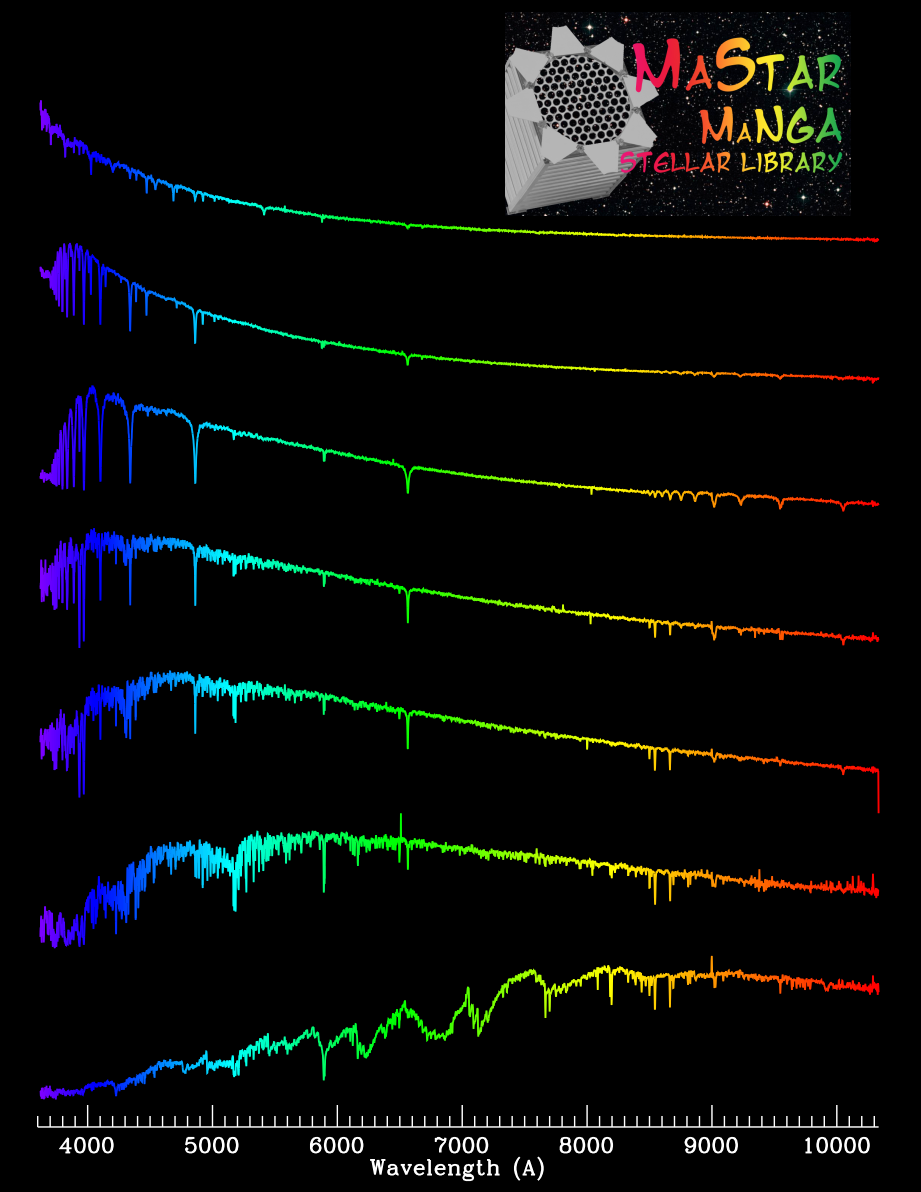MaStar Overview
MaNGA Stellar Library (MaStar) is a stellar spectral library with a wide coverage of stellar parameters, high quality calibration, and identical observing setup as the MaNGA survey.
The spectra cover 3,622-10,354 Angstrom with a spectral resolution around R~1800. In DR17, we release all the data obtained for the MaStar program, including both good and bad quality ones. In total, there are 24,130 unique good stars with 59,266 good quality visit spectra. Among these, 11,817 unique stars were targeted to build the stellar library, and 12,345 unique stars were targeted as spectrophotometric standards, with an overlap of 32 stars between the two categories. The 24,130 unique good stars correspond to 24,290 unique MaNGAIDs, with some stars correspond to more than one MaNGAIDs. In addition to good quality spectra, we also provide files for spectra that were filtered out due to quality issues, some of which may be useful for other purposes.
This release will be described in detail in Yan et al. (in prep), and is also featured in the DR17 Data Release paper Abdurro’uf et al. (2022). The previous release DR15 was described by Yan et al. (2019).
Please cite these papers when using the library, and please also follow the general guide to citing SDSS.
MaStar Observations
The observations are obtained mostly by piggybacking on the APOGEE-2 survey during bright time, using MaNGA fiber bundles and the BOSS optical spectrographs. The use of fiber bundles allows us to obtain much more accurate flux calibration than previous SDSS surveys of stars that use single fibers; see the Observing Strategy page for details of our observations.
For detailed information about the instruments, please see the MaNGA Instrument page.
MaStar Data in DR17
The DR17 version of the MaStar Library is significantly expanded compared to DR15. We have finished all observations. This release includes all the data. Of all the stars observed, we have selected a subset of stars, termed 'good stars', with good quality visit spectra, termed 'good visits'. Each 'visit' is defined as the observation obtained for a star on a single night. This is the primary product of this release. It includes 59,266 good quality single visit spectra for 24,130 unique good stars. Most stars are assigned a unique MaNGAID. A small number of stars have multiple MaNGAIDs associated with each of them.
The DR17 release includes a summary file called 'mastarall-(version).fits' and a spectra file called 'mastar-goodspec-(version).fits'. The summary file contains a 'GOODSTARS' table, a 'GOODVISITS' table, an 'ALLSTARS' table, and an 'ALLVISITS' table. The 'GOODSTARS' table lists the ID, location, photometry, and input stellar parameters, etc. for all stars with good quality visit spectra. It has one entry per unique MaNGAID. The 'ALLSTARS' table lists these information for all stars targeted regardless of whether it has good quality visit spectra or not.
The 'GOODVISITS' table lists the information needed to locate all good quality visits for each good star, the radial velocity used to shift each spectrum to restframe, and spectral quality information. The 'ALLVISITS' table lists these information for all visits regardless of the quality. The spectra file contains all the good quality single visits spectra, matching the order of entries in the 'GOODVISITS' table. We also provide a spectra file called 'mastar-badspec-(version).fits', which contains all the visit spectra we rejected due to quality issues.
- The MaStar Catalog page provides the details about the summary file -- 'mastarall'.
- The MaStar Spectra page provides the details about the spectra file -- 'mastar-goodspec'.
- The MaStar Data Access page provides information about ways to access the data.
- The MaStar Crossmatch page provides the crossmatched photometry of MaStar stars from Gaia, 2MASS, PanSTARRS-1, and spectral type information collected from Simbad.
- The MaStar Stellar Parameters page provides four catalogs of stellar parameters using different approaches and a median 'best' catalog.
- The MaStar Caveats page lists important usage caveats for the data. You are strongly encouraged to read this.
- The MaStar Tutorial page provides tutorials for using the MaStar data.
In addition, DR17 also contains the raw data from the six years of observations, the intermediate data reduction pipeline (DRP) products, and the combined, flux-calibrated, individual visit and individual exposure spectra.
For more detailed information on the MaStar survey in DR17, see the list of links on this page.
MaStar Data Access
Science Archive Server (SAS)
MaStar individual epoch spectra, individual exposure spectra, and MaStar summary tables are available as FITS files through the Science Archive Server (SAS), which can return FITS spectra either individually or in bulk. For more information on retrieving MaStar data from the SAS, see MaStar Data Access page.
The Science Archive Webapp provides a searchable interface for MaStar spectra, and includes an interactive view of spectra, and a data download facility (supports both rsync and wget).
Sky Server
Information for individual MaStar targets are now shown in the SkyServer Explore tool, such as for this sample MaStar target star.
You can search for MaStar data using Structured Query Language (SQL) with the SkyServer SQL Search tool. MaStar summary data are in the mastar-goodstars table and the mastar-goodvisits table.
CasJobs
You can search for MaStar data within the mastar summary table more flexibly with the CasJobs data access tool. You can save results into a personal MyDB database for later analysis.
MaStar data are part of the DR17 context - don't forget to change to the DR17 context when you want to find MaStar data. MaStar summary data are in the mastar-goodstars table and the mastar-goodvisits table.





